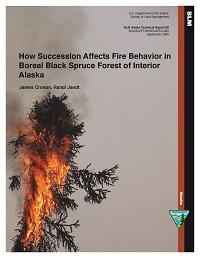How Succession Affects Fire Behavior in Boreal Black Spruce Forest of Interior Alaska

This report summarizes research funded by the Joint Fire Science Program (JFSP) that assessed the relationship between stand age and fire behavior in the black spruce forest type of interior Alaska. Forest canopy and substrate data were collected from 21 sites representing a time sequence of stand age ranging from two to 227 years. These data were used in fire behavior prediction models to estimate flammability for three weather scenarios. Regression analysis revealed a high degree of correlation between predicted and observed rates of spread (ROS) and suggested predicted fire behavior reflects actual fire behavior. A novel approach to modeling fire behavior was explored using fire behavior prediction models for surface fire, crown fire ignition, and crown fire sequentially. Specific components of the fuel complex were compared with increasing stand age during the first 100 years of stand development. The most prominent trend was the synchronized development of the feathermoss layer of the forest floor and the overstory. Measures of both fuel categories were essentially zero in stands aged < 20 years, then increased steadily with stand age. Leaf litter and coarse (i.e., 1/4 inch to 3 inch diameter) downed woody debris (DWD) had the opposite relationship with stand age; both fuel categories rapidly increased to their highest levels in stands aged < 20 years before declining with stand age. Beyond 100 years, the only notable relationships between the fuel complex and stand age was a tenuous correlation that suggested fine canopy fuel loading continued to increase slightly with stand age. Some fuel categories had no discernable relationship to stand age for the entire span of stand ages sampled. These included measures of groundcover and fine (i.e., less than 1/4 inch) DWD.
Cluster analysis of predicted fire behavior suggested three phases of fuel succession: the pioneer phase (stands aged < 20 years) corresponded to the lowest measures of fine fuels and predicted fire behavior, the transition phase (stands aged 20-45 years) defined a period of increasing measures of fine fuels and predicted fire behavior, and the forested phase (stands aged > 45 years) had the highest measures of fine fuels and predicted fire behavior. Sensitivity of predicted fire behavior to weather increased with increasing stand age as fuels became less of a limiting factor on fire behavior. The response of ROS to stand age was correlated with increased feathermoss coverage and canopy bulk density (CBD) during the first 45 years of stand development. This correlation ended in stands aged > 45 years because these fuel categories reached threshold values where further increases had a marginally declining influence on ROS. Fire-line intensity (FLI) increased throughout the study time period and was primarily influenced by available fine fuel loading.
